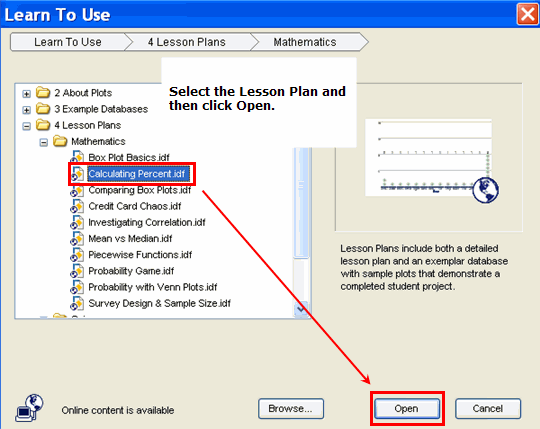EDTE 233
Teaching Problem-Solving with Educational Technology.
A Rationale for using Data Bases
Data bases are wonderful learning tools because they embody so much of the learning process. Once teachers begin to understand how to apply this technology to curricular projects, learning truly becomes a process of give and take. Here are some of the highlights of that exciting experience.
1. Obtaining Background: Students need to read or research designated curricular topics. This includes going on field trips, watching videos, and listening to visitors to the classroom.
2. Planning: Students participate in brainstorming that gives them the opportunity to recall large amounts of data. Recalling data also serves to develop concepts.
3. Organizing: Students learn and apply organizational skills when they plan a data base.
4. Gathering Facts: Students extend their research skills as they fit facts into categories.
5. Using Tools: Students learn to create and use a data base to store data in an organized, efficient manner.
6. Questioning: Students learn to formulate questions that result in the extraction of information from the data base.
7. Hypothesizing: Students learn to state and test their own hypotheses.
8. Analyzing: Students quickly understand associations and relationships within the data base.
9. Evaluating: Students understand the difference between data and information.
Using a data base as a teaching tool is quite different from using word processors in the classroom. Just as the use of word processing requires planning, the use of the data base as a tool requires strategies that go beyond a few afternoon sessions in the computer lab. It is important,
therefore, to incorporate the Inductive Strategy of Hilda Taba into the learning process in order to succeed in integrating data bases with the curriculum.
Databases require additional preparation when used as an educational tool.
If you think about fields as categories, you'll be taking a quantum leap. When you use these categories with children, you can consider categories as concepts. Your objectives are to
help children develop concepts and apply new knowledge.
Inductive Reasoning
Inductive reasoning is a branch of logic. In a valid inductive argument, the conclusion (consequent) is believed to be true on the basis of its antecedents. For example, when all swans are observed to be white, a student may easily reach the conclusion that all swans are indeed white. A generalization is made based on the evidence gathered. However, when a black swan is observed, the generalization must be thrown out based upon the new data (antecedents). Do you know that the black swan is native to Australia? Well, it is! Before the great voyages of discovery, the black swan was never observed in Europe and England, and it remained unknown to westerners until Australia was discovered and explored. That swans could be black would have been a false conclusion by anyone other than the indigenous people of the land down under before the exploration of
the Australian continent!


Hilda Taba believed that students make generalizations only after data are organized. She believed that students can be led toward making generalizations through concept
development and concept attainment strategies. In A Teacher's Handbook to Elementary Social Studies, Hilda Taba describes generalizing as a higher order of thinking when compared to forming concepts.
Hilda Taba
"Generalizations like concepts, are the end products of a process of an individual's abstracting from a group of items of his experience those elements of characteristics the items share, and expressing
his recognition of this commonality in a way that is convincing to others. The two major differences between concepts and generalizations are, first of all, that in generalizations the verbal form of the process is expressed as a sentence rather than a word or phrase as in the case of concepts, and second, that generalizations are here taken as representing a higher level of thinking than concepts in that they are a statement of relationships among two or more of these concepts" (1971, p. 72).
Taba, H., Durkin, M. C., Fraenkel, J. R., & NcNaughton, A. H. (1971). A teacher's handbook to
elementary social studies: An inductive approach (2nd ed.). Reading, MA: Addison-Wesley.
Retrieved from http://www.csus.edu/indiv/m/mcvickerb/sj_why_use_databases.html
Database Assignment: Part 1 - Using a Database
Preparation:
Database Vocabulary
Use Wikipedia or Dictionary.com or another online resource to define the following terms;
field
record
query
database
spreadsheet
(You may add any additional terms that you need to define.)
Work in groups of 2 or 3;
Open the Inspiration program.
Create a Venn diagram to compare and contrast database vs. spreadsheet.
Why you would choose to use a database rather than a spreadsheet? (Describe)
Include all of the above information on the graphic organizer (Venn diagram)
Insert or attach the Venn diagram to your All About Me web page.
AND
upload the Venn diagram to our edte233googlegroups page.
http://groups.google.com/group/edte233?hl=en
Now we will explore a new program called InspireData.
Download and install InspireData (have the computer in Windows)
After downloading and installing the program, open the program and click on Learn To Use
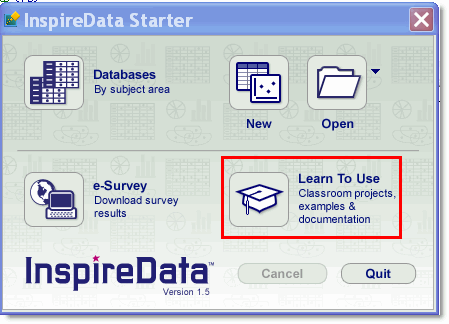
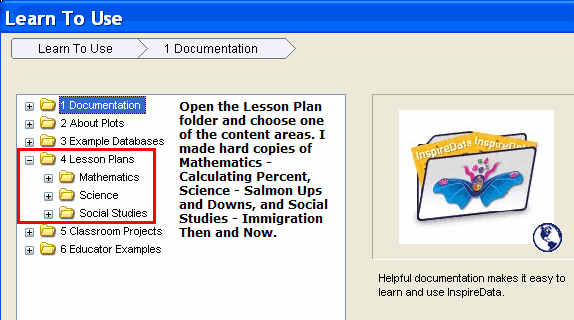
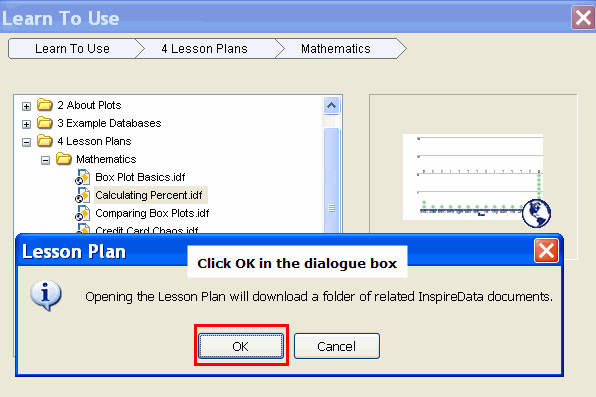
Save the downloaded files: Navigate to InspireData >> Learn To Use >> Lesson Plans
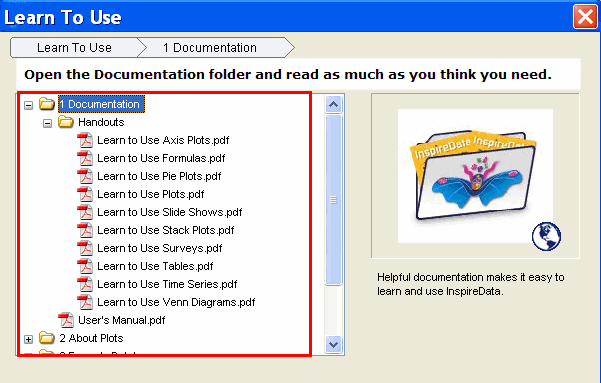
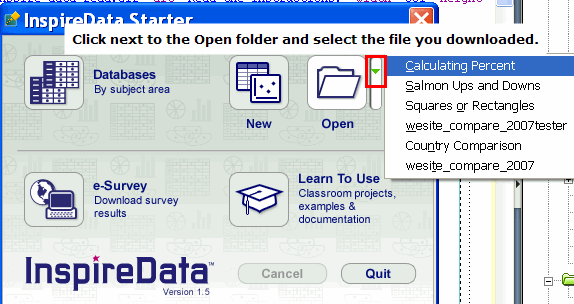
1. As a group, explore the lesson.
-
Could you use this lesson with your students? Why or why not?
-
Can you think of an area of your curriculum that would benefit from the incorporation of bar (stack) graphs, line graphs, pie charts?
2. Open the Databases By Subject Area and the e-Survey folders. Explore the samples and select one that might be a good fit in your subject area or grade level.
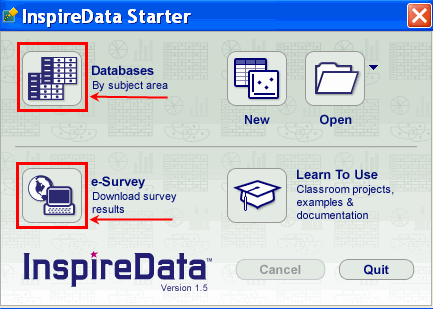
3. With your group, create a brief (5 min.)presentation on Google web page (Google page creator) to share what you learned with the class. Offer some suggestions on how the selected lesson(s) might be used with your students or staff. Be sure to publish the page and record the URL.
Database Assignment: Part 2 - Creating a Database
Work in groups of 3 or 4.
You are part of a team of explorers from a unique planetary system called Esa-batad.
Your courageous team of jaunty researchers has been selected by your fearless leader for the special purpose of locating a suitable place on the continent of Africa as a potential settlement for your
fellow Esa-ba-tadians back home. You all are especially qualified for this mission because of your gift for quickly organizing and interpreting data that otherwise may be confusing to ordinary Esa-ba-tad inhabitants, especially young ones.
Listed below are the conditions that must be met as closely as possible.
- New Esa-ba-tad must be near at least one year-round water source.
- Its temperature must range roughly between 65 - 99 degrees Fahrenheit, and
- Its rainfall must have an annual total of at least 30 inches.
- Its landforms must include mountains, beaches, and fertile valleys.
- There may be minor Earthling settlements in the area selected, but the colonists
wish to avoid unnecessary contact with native peoples. - However, if contact is made, Esa-ba-tadians are proficient in French, and they worship a variation of the Muslim religion.
- They wish to avoid any confrontations, especially those involving religious beliefs.
- Esa-ba-tad people eat only fruit and nuts, but they love coffee and tea sweetened with sugar. These things must grow in New Esa-ba-tad.
- There is no specific, physical size for the new colony. Esa-ba-tadians have the enviable ability to shrink or enlarge as space permits, yet their caloric intake never
changes. They may share this acquired skill at some future date with humans.
Is there a place in Africa where New Esa-ba-tad can be formed?
Create data bases using the Africa Internet sites provided.
Organize your data bases around the conditions above.
Sort or filter the data bases until you find the best possible place
for these brave Esa-ba-tad colonists.
One final note: The Esa-ba-tad researchers have the uncanny ability to generate insightful questions that filter data so that the most meaningful information might be gained. They are fortunate to have an Oracle with them who will answer their queries. Unfortunately, the Oracle is rather bad-tempered due to time-warp sickness and will only entertain two such inquiries. Ask carefully and your task may be simplified by the elimination of many African countries that clearly do not fit the requirements of the Esa-ba-tad colonists.
Africa Atlas: Maps and Online Resources
http://www.infoplease.com/atlas/africa.html
African Studies Center: African Countries
http://www.africa.upenn.edu//Home_Page/Country.html
The C.I.A. World Factbook - Africa
http://www.umsl.edu/services/govdocs/wofact2007/reference_maps/africa.html
Schedule
Resources
http://www.csus.edu/indiv/m/mcvickerb/wfiles.html
Instructor
Joyce Dibble
Students will need an e-mail account and computer access to the Web. All Sacramento State students enrolled in one or more units can create a SacLink account for e-mail. Although a home computer with Internet access running Microsoft Internet Explorer, Mozilla Firefox or Netscape Navigator would be beneficial, students can access the Internet from one of the campus student labs. Check out System Check and Computer Hardware Recommendations for more information about equipment.
Last updated: 10/27/2007

